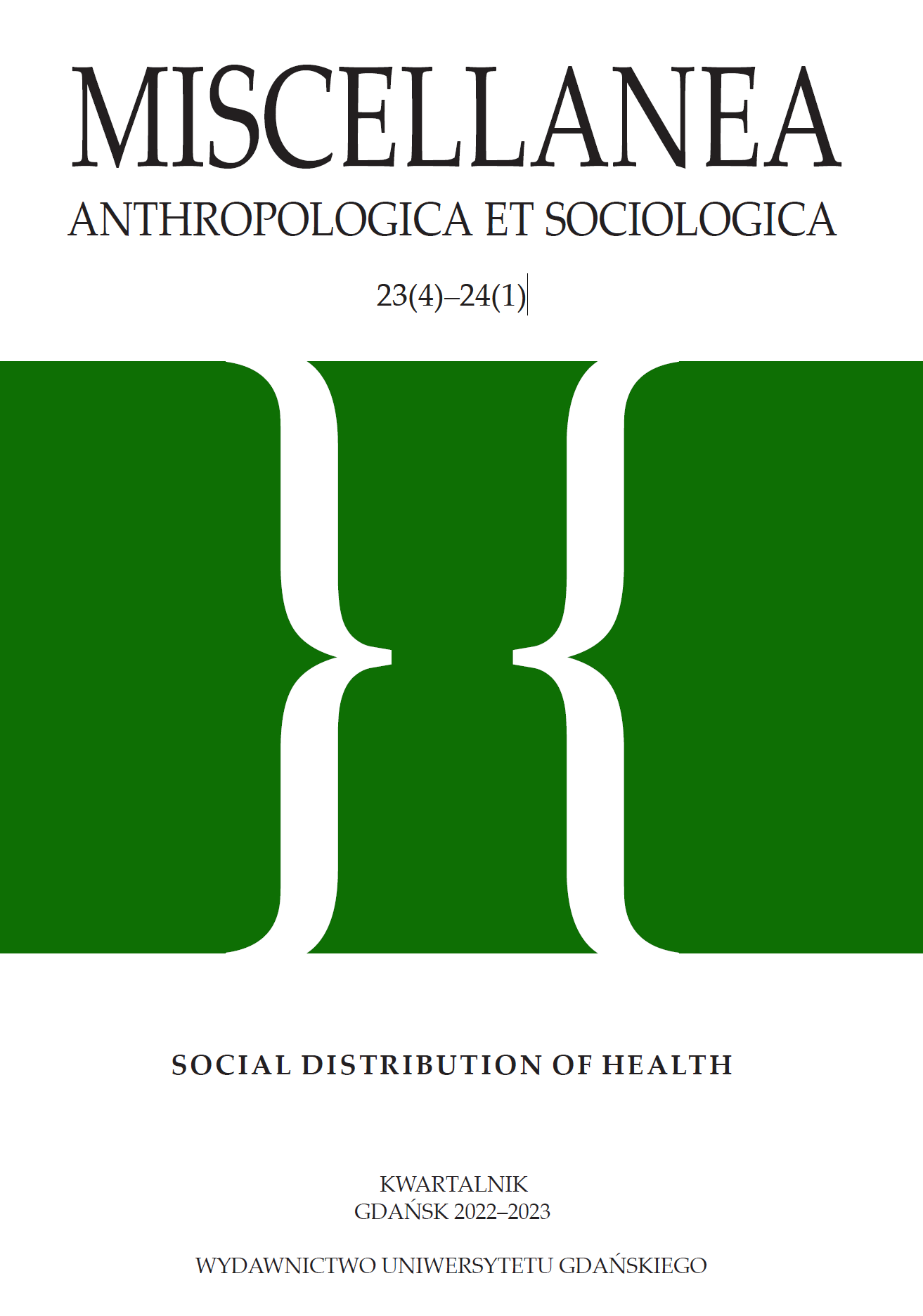Social and Spatial Determinants of the Integration of Blind, Visually Impaired and Sighted People on the Example of the Sailing Cruise of the “See the Sea” Foundation
Słowa kluczowe:
visual impairment, integration of blind and sighted people, seagoing cruiseAbstrakt
The subject of the analysis is the cooperation between blind and sighted people during a seagoing integration cruise. Integration is understood here as the result of joint sailing activities of people with different visual perception who participated in the cruise on the ship Zawisza Czarny. In the text, I put forward the thesis that integration is the result of the readiness of able-bodied and disabled people to create a “common world”. Therefore, I conducted qualitative research to verify this thesis. The aim of the research was to identify the factors and principles that favour the social integration of sighted, visually impaired and blind people during a ship cruise. I used primary data from in-depth interviews and secondary data from documentation to analyse social and spatial factors that determine the integration of able-bodied and disabled people during a sea voyage as part of the See the Sea project. In the theoretical dimension, the text is based on the assumptions of the integrative model of disability, an important component of which is the concept of the social integration of able-bodied and disabled people.
Downloads
Bibliografia
Albrecht G.L., 1976, The Sociology of Physical Disability and Rehabilitation. Pittsburgh: University of Pittsburgh Press.
Barnes C., Mercer G., 2006, Independent Futures: Creating User-Led Disability Services in a Disabling Society, Bristol: The Policy Press.
Barnes C., Mercer G., 2008, Niepełnosprawność, P. Morawski (transl.), Warszawa: Wydawnictwo Sic!
Casey E., 1987, Remembering: A Phenomenological Study. Bloomington, IN: Indiana University Press.
Classen C., 1990, Sweet Colors, Fragrant Songs: Sensory Models of the Andes and the Amazon, “American Ethnologist”, no. 17, issue 4.
Cotter A.M., 2007, This Ability. An International Legal Analysis of Disability Discrimination, Hampshire: Ashgate Publishing Ltd.
Emmison, M. 2004, The Conceptualization and Analysis of Visual Data [in:] D. Silverman (ed.), Qualitative Research. Theory, Method and Practice, London – New Delhi: SAGE Publications.
Friedman A., 2012, Believing Not Seeing: A Blind Phenomenology of Sexed Bodies, “Symbolic Interaction”, vol. 35, no. 3.
Gąciarz B., 2014, Integracja społeczna osób niepełnosprawnych jako wyzwanie dla nauki i praktyki społecznej. Wprowadzenie, “Studia Socjologiczne”, vol. 213, no. 2.
Gąciarz B., 2015, Socjologia niepełnosprawności. Instytucje a integracja społeczna osób niepełnosprawnych w Polsce [in:] A. Ostrowska, M. Skrzypek (eds.), Socjologia medycyny w Polsce z perspektywy półwiecza. Nurty badawcze, najważniejsze osiągnięcia, perspektywy rozwoju, Warszawa: Wydawnictwo IFiS PAN.
Goodley D., 2011, Disability Studies. An Interdisciplinary Introduction, Los Angeles – London – New Delhi: Sage.
Herzfeld M., 2004, Antropologia. Praktykowanie teorii w kulturze i społeczeństwie, M.M. Piechaczek (transl.), Kraków: WUJ.
Holstein J., Gubrium J., 2004, The Active Interview [in:] D. Silverman (ed.), Qualitative Research. Theory, Method and Practice, London – New Delhi: SAGE Publications.
Howes D., 2003, Sensual Relations: Engaging the Senses in Culture and Social Theory, Ann Arbor: University Of Michigan Press.
Howes D., Classen C., 2014, Ways of Sensing. Understanding the Senses in Society, London – New York: Routledge.
Krause A., 2004, Normalizacyjne podłoże integracji [in:] G. Dryżałowska, H. Żuraw (eds.), Integracja społeczna osób niepełnosprawnych, Warszawa: Wydawnictwo Akademickie Żak.
Leonardi M., Bickenbach J., Ustun T.B., Kostanjsek N., Chatterji S., 2006, The Definition of Disability: What Is in a Name?, “The Lancet”, vol. 7.
Lofland J., Snow D., Anderson S., Lofland L.H., 2006, Analyzing Social Settings. A Guide to Qualitative Observation and Analysis, Toronto: Thomson Wadsworth.
Maracewicz T., 2013, Zawiszowe Vademecum, Gdynia: Centrum Wychowania Morskiego ZHP.
Maseide P., Grottland H., 2015, Enacting Blind Spaces and Spatialities: A Sociological Study of Blindness Related to Space, Environment and Interaction, “Symbolic Interaction”, vol. 38, issue 4.
Michalko R., 2002, The Difference that Disability Makes, Philadelphia: Temple University Press.
Miller J., Glassner B., 2004, The ‘Inside’ and the ‘Outside’. Finding Realities in Interviews [in:] D. Silverman (ed.), Qualitative Research. Theory Method and Practice, London – New Delhi: SAGE Publications.
Niedbalski J., Racław M., Żuchowska-Skiba D., 2017, Wstęp. W kierunku nowego paradygmatu niepełnosprawności, “Acta Universitatis Lodziensis. Folia Sociologica”, issue 60.
Olivier M.,1996, A Sociology of Disability or a Disablist Sociology? [in:] L. Burton (ed.), Disability and Society: Emerging Issues and Insights, London – New York: Longman.
Ostrowska A., 1994, Niepełnosprawni w społeczeństwie: postawy społeczeństwa polskiego wobec ludzi niepełnosprawnych (raport z badań), Warszawa: IFiS PAN.
Ostrowska A., Sikorska J., 1996, Syndrom niepełnosprawności w Polsce. Bariery integracji, Warszawa: Wydawnictwo IFiS PAN.
Ostrowska A., 2009, Niepełnosprawność, rehabilitacja i integracja społeczna osób niepełnosprawnych [in:] A. Ostrowska (ed.), Socjologia medycyny: podejmowane problemy, kategorie analizy, Warszawa: Wydawnictwo IFiS PAN.
Ostrowska A., 2015a, Niepełnosprawni w społeczeństwie 1993–2013, Warszawa: Wydawnictwo IFiS PAN.
Ostrowska A., 2015b, Stosunek społeczeństwa do osób z niepełnosprawnością na podstawie badań z lat 1993–2013. Jak postępuje proces integracji?, “Zdrowie Publiczne i Zarządzanie”, vol. 13, no. 3.
Pietrowiak K., 2019, Świat po omacku. Etnograficzne studium (nie)widzenia i (nie)sprawności, Toruń: Wydawnictwo Naukowe Uniwersytetu Mikołaja Kopernika.
Porkertova H., 2022, Revising Modern Divisions Between Blindness and Sightedness: Doing Knowledge in Blind Assemblages, “The Sociological Review”, vol. 70, no. 3.
Reindal S.M., 2009, Disability, Capability and Special Education: Towards a Capability-Based Theory, “European Journal of Special Needs Education”, vol. 24, no. 2.
Searle J.R., 2010, Making the Social World, Oxford: Oxford University Press. Scott R.A., 1969, The Making of Blind Man: A Study of Adult Socialization, New York: Russell Sage Foundation.
Whitburn B., Michalko R., 2019, Blindness/Sightedness: Disability Studies and the Defiance of Division [in:] N. Watson, S. Vehmas (eds.), Routledge Handbook of Disability Studies, London – New York: Routledge.
WHO, 2011, World Report on Disability, Geneva: World Health Organization.
Ven van de L., Post M., Witte de L., Heuvel van den W., 2004, It Takes Two to Tango: The Integration of People with Disabilities into Society, “Disability and Society”, vol. 20, no. 3.
Internet sources and legal acts
https://www.powersport.pl/pl/wydarzenia-specjalne/zobaczyc-morze
https://www.zobaczycmorze.pl/?page_id=369
Convention on the Rights of Persons with Disabilities signed in New York on 13 December 2006 r., Dz. U. 2012, nr 0, poz. 1169

 Uniwersyteckie Czasopisma Naukowe
Uniwersyteckie Czasopisma Naukowe




